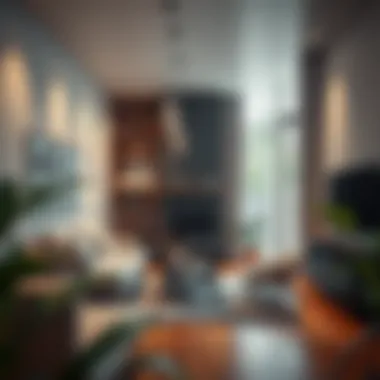Mastering Free Room Drawing Techniques for Design


Intro
Drawing spaces freehand captures the essence of design in a way that digital tools can't always replicate. It has a charm, an intimacy, that allows designers and homeowners alike to visualize their thoughts onto paper. As technology marches forward, the fundamental techniques of free room drawing still hold significant merit. In this guide, we will explore various methodologies, tools, and applications that enhance spatial design and visualisation. Understanding how to draw spaces can lead to better design decisions, grounded in both current trends and timeless principles.
Throughout this article, we'll highlight several critical aspects of free room drawing, from traditional methods to the integration of digital tools. This exploration aims to refine your approach to interior design, offering insights whether you're a seasoned designer or a DIY enthusiast looking to elevate your spatial planning skills.
Furniture Styles and Trends
Understanding furniture styles and trends is key to effectively drawing space. Your sketches should reflect the aesthetic you're aiming for in a particular room. Let's break this down further.
Modern vs. Traditional: Understanding the Aesthetics
Modern furniture, characterized by clean lines and minimalist design, contrasts sharply with traditional styles, which often embrace intricate details and ornate embellishments. When sketching, consider how you want the space to reflect these aesthetics.
- Modern Furniture: Focus on simplicity. Think of platforms and angular shapes. How about a sleek sectional couch positioned angularly against the wall to create flow?
- Traditional Furniture: Here, you might visualize heavy, elegant pieces that draw the eye. A classic mahogany dining set could be your starting point, inviting warmth and a sense of history into your composition.
When drawing, ask yourself, "What feelings should this space invoke?" Your sketches must relay the overall vibe you aspire to achieve.
Color and Material Trends: What's In and What's Out
Color and material choices play a crucial role in setting the atmosphere of any room. Knowing the current trends can radically influence your design approach.
- Colors: Earthy tones are making headway, with shades like terracotta and moss green carving out spaces of calm and connection with nature. On the flip side, over-saturated hues or neon shades are largely seen as passé.
- Materials: Natural materials are reigning supreme; think of oak, wool, and jute. These materials not only bring depth but also add an organic feel to your designs.
Incorporating these colors and materials into your free drawings can help establish a more relevant and contemporary aesthetic that resonates with potential homeowners or clients.
"Design is not just what it looks like; design is how it works." – Steve Jobs
Your sketches should not only focus on beauty but also on functionality.
Furniture Care and Maintenance
A well-designed room is also about maintaining the pieces within it. Understanding furniture care can enhance longevity and sustain the aesthetic appeal of your chosen pieces.
Tips for Prolonging the Life of Your Furniture
Taking good care of your furniture is crucial, especially when your drawings and designs rely on specific items. Here are a few tips:
- Regular Cleaning: Dust and dirt can dull the finish of your furniture. Keep materials like microfiber cloths handy.
- Protecting Against Sunlight: Direct sunlight can fade colors. Use window treatments that filter light.
- Routine Checks: Inspect for any wear and tear regularly; handling issues early can save a lot of trouble down the line.
DIY Repair Hacks for Common Furniture Issues
Sometimes furniture gets a little worse for wear. Here are some simple hacks to repair issues without needing to call in a pro:
- Scratches on Wood: A walnut or a marker matching the wood color can do wonders. Rub it into the scratch for a quick fix.
- Squeaky Chairs: A bit of lubricant can silence those annoying squeaks.
By carrying these tips in mind while sketching your space, you'll create a visual narrative that not only looks splendid on paper but also functions well in real life.
Understanding Free Room Drawing
Free room drawing is an integral aspect of the architecture and interior design space, serving as the bedrock upon which creative visions are often built. To grasp the significance of this practice, we must first appreciate its role in fostering spatial awareness and conceptual development. By mastering free room drawing, individuals not only enhance their artistic skills but also their ability to communicate intricate design ideas visually.
Definition and Importance
At its core, free room drawing refers to the artistic representation of spaces without the constraints of precise measurement or technical drawing tools. This method encourages a more liberated approach to design, inviting creativity to flourish among lines and forms. Think of it as gathering your thoughts on paper, where the focus is less about perfection and more about capturing essence and feeling.
The importance of free room drawing cannot be overstated. It enables designers to brainstorm ideas rapidly, visualize concepts more effectively, and experiment with different spatial arrangements. With this foundation, designers can explore innovative solutions in a way that software and rigid methods might restrict.
Moreover, freehand sketches have an invaluable role in client presentations. They offer a personal touch that can resonate more profoundly than sterile digital renderings, making it easier to convey ideas that align with the client's vision. By prioritizing the emotive aspect of spatial design, free room drawing serves as both a functional tool and an art form.
Brief History of Room Drawing Techniques
The roots of room drawing techniques can be traced back to ancient civilizations, from the Egyptians to the Greeks, where architecture was primarily illustrated by hand. Before the advent of advanced tools and digital technology, architects relied on these sketches to guide construction and layout. This historical practice was more than mere aesthetics; it was a necessity for planning cities and structures in harmonious ways.


As centuries passed, the art of drawing evolved significantly. The Renaissance period brought about an explosion of creative thought and technical prowess, with artists like Leonardo da Vinci and Michelangelo pushing the boundaries of representation. They introduced perspective drawing techniques that offered depth and realism, allowing viewers to immerse themselves within the depicted spaces.
With the 20th century came radical changes in art and design philosophy. The Modernist movement sought to strip away unnecessary embellishments and focus on form and function, which further influenced drawing methods. Architects began to adopt more abstract styles, moving beyond realism to express ideas and concepts in a manner that suited a rapidly changing world.
Today, while digital tools have revolutionized how designers work, free room drawing retains its value. It is a skill that can nurture creativity, intuition, and the ability to communicate complex ideas simply and effectively. Understanding this heritage of room drawing equips modern designers and enthusiasts with a richer perspective, enhancing their appreciation of both traditional and contemporary practices.
"Technical skill without a creative problem is nothing, yet the freedom of intuition in drawing can transform mundane space into something extraordinary."
Fundamental Techniques in Free Room Drawing
In the realm of interior design, Free Room Drawing emerges as a pivotal foundational skill. It's not merely about putting pencil to paper; it's about translating a vision into a tangible space through various fundamental techniques. Mastering these techniques is essential as they set the stage for effective spatial design, enabling designers and enthusiasts to manifest their ideas beautifully.
Freehand Sketching
Freehand sketching stands at the heart of free room drawing. This technique involves capturing the essence of a space quickly and with fluidity. The beauty of freehand is its unfiltered expression. It allows for creative freedom, offering designers a way to brainstorm ideas without the constraints of more rigid methods.
When engaging in freehand sketching, it’s important to focus on the flow and gestures of the room rather than minute details. Think of it as writing poetry with lines and shapes, where your only goal is to convey the emotional weight of the space. The rough edges and spontaneous strokes can often communicate more than polished drawings ever could.
Key benefits of freehand sketching include:
- Flexibility: You can express ideas rapidly, allowing for more exploration in the design process.
- Low Barrier to Entry: It doesn’t require advanced tools or training; just grab a pencil and some paper.
- Improved Visualization Skills: Engaging regularly in freehand work hones your ability to visualize spaces mentally.
Perspective Drawing Concepts
Next we come to perspective drawing, which adds depth to your free room sketches. Understanding perspective is essential as it determines how objects are situated in space and how they appear to the eye. There are various types of perspectives to consider, such as one-point and two-point perspectives, each offering unique ways to portray depth.
Incorporating perspective into your drawing allows for a more realistic representation of space. It’s akin to looking through a window – you get a sense of how everything fits together within the confines of the room. It’s not just about making the room look realistic; it’s about helping viewers mentally walk through the space.
To effectively use perspective:
- Establish a Horizon Line: This line serves as your viewer's eye level within the drawing.
- Vanishing Points: Identify where lines converge, guiding the viewer’s eye into the depth of your space.
- Proportion: Ensure that objects closer to the viewer appear larger than those farther away.
Using Scale and Proportion
Scale and proportion are crucial elements in creating an effective room drawing. These concepts relate to how objects relate to each other within a space and help maintain realism. Understanding these elements means ensuring that the furniture, windows, and other aspects are not only aesthetically pleasing but also functional within the given area.
When placing items in your drawing, it’s helpful to think of them in terms of human scale. Imagine how a person would interact within that space. If the furniture looks oversized or too small, it will create discomfort and suggest a lack of harmony in your design.
Here are some tips for using scale and proportion:
- Measurement Practices: Familiarize yourself with standard size dimensions for furniture and fixtures.
- Testing Proportions: Use simple tools like rulers or digitally available grid templates to maintain proportions while sketching.
- Visual Aids: Consider using photographs or sketches of actual items to help ground your proportions in reality.
By integrating scaling techniques, one can seamlessly weave the essence of design into practical execution, leading to spaces that are not only visually appealing but also livable.
Overall, mastering the fundamental techniques in free room drawing sets the groundwork for any designer or enthusiast delving into spatial design. From spontaneous freehand sketches to realistic perspectives and maintaining proper scale, these techniques empower creators to express their environments with clarity and intent.
Essential Tools for Free Room Drawing
When it comes to free room drawing, having the right tools can be a game changer. These tools not only enhance creativity but also allow for precision and detail that can make or break a design. Understanding what tools are available and how to choose them is a pivotal part of mastering this skill.
Traditional Drawing Tools
Traditional tools hold a special place in the hearts of designers, often being the first step in their artistic journey. Pencils, sketchbooks, and a plethora of drawing implements create a tactile experience with a direct connection to the canvas.
- Graphite Pencils: Different grades of pencils are essential. Softer pencils (like 2B or 4B) enable darker lines, while harder pencils (HB) are perfect for finer, more precise details.
- Charcoal and Pastels: For a unique texture and feel, charcoal is unbeatable. It allows for expressive lines and shading that can add depth to a sketch. Pastels offer vibrant colors that can bring designs to life, though they require a bit more handling.
- Erasers and Blending Tools: A good eraser isn’t just for mistakes; it’s also a blending tool that can soften lines and create gradients.
- Compass and Rulers: These tools help maintain accuracy in proportions and measures, which is crucial when translating ideas into actionable designs.
Despite the rise of digital technology, these traditional tools still contribute to the core of free room drawing, grounding designers in the fundamentals.
Digital Tools and Software
The digital realm has undeniably revolutionized the landscape of design work. The tools available can enhance creativity and efficiency in ways traditional methods simply can't match. Popular software and applications such as SketchUp, AutoCAD, and Revit enable designers to create detailed layouts with ease.
- SketchUp: Perfect for 3D modeling, it's user-friendly and allows for quick adjustments to designs. The intuitive interface helps users visualize spaces effectively.
- AutoCAD: This is a staple in contemporary design. It enables precise drafting and is widely used among architects and interior designers alike.
- Revit: Tailored more towards building information modeling (BIM), this software allows for real-time collaboration. It’s particularly useful for projects involving multiple stakeholders.
- Tablet and Stylus: These devices mimic the feeling of drawing on paper while offering the flexibility of digital editing. Programs like Procreate have become favored by many for sketching concepts on the go.


Transitioning to digital tools can be intimidating, but the advantages they offer often outweigh the learning curve.
Choosing the Right Tools for Your Needs
Selecting the right tools is crucial and can depend greatly on personal preferences and specific project goals. Here are some considerations:
- Assess Your Skill Level: Beginners might find that starting with basic tools is best. Once comfortable, they can explore more complex digital options.
- Consider the Project Type: For quick concepts, traditional tools may suffice. However, detailed professional projects benefit from advanced software that can handle intricate designs and client presentations.
- Budget: High-end tools might not always mean better output. Find a balance between quality and affordability; many great tools exist at various price points.
- Personal Comfort: Ultimately, choose tools that feel right to you. Whether it's the grip of a pencil or the interface of software, personal preference plays a significant role in your creative process.
"The right tools don’t just aid in execution; they help in the conceptualization of ideas. Select wisely, and they will elevate your designs."
Tools are more than just physical items; they embody the techniques and skillset of a designer. As you work on your ability in free room drawing, remember that the tools you choose can enhance or hinder your creative vision.
Applications of Free Room Drawing in Interior Design
Free room drawing holds a pivotal place in the realm of interior design, serving as a fulcrum around which ideas and spaces pivot. The ability to visualize concepts and their spatial relationships through drawing cannot be underestimated. It provides clarity and direction for both designers and clients, ultimately aiding in the creation of functional and aesthetically pleasing environments. By harnessing effective applications of free room drawing, designers can not only elevate their work but also facilitate more informed decisions.
Concept Development
In the early stages of any design project, the conceptual phase is vital. Free room drawing allows designers to explore ideas informally and quickly. During concept development, a sketch can bridge gaps that verbal descriptions may not effectively communicate.
These drawings act as a canvas for creativity, enabling designers to visualize different themes, color palettes, and furniture layouts. They’re not about perfection; instead, they capture the essence of an idea that can be refined later.
For instance, sketching a living room layout could help a designer envision whether a sectional sofa complements the space before any resources are allocated. The fluidity of these sketches allows for countless iterations, adapting along the way until the concepts solidify.
Space Planning and Layout
An effective layout is the backbone of a successful interior design project. Free room drawing assists in space planning by providing a visual means to assess how different elements work together. Recognizing spatial relationships is crucial, as the arrangement will influence the functionality and flow within a room.
Designers can jot down the dimensions of the room, alongside furniture pieces, eliminating the guesswork about how everything fits. For example, sketching out a dining area can help in determining how many chairs will fit around a table without obstructing walkways or access points. Moreover, this technique permits designers to rearrange elements easily, evaluating how various layouts alter the overall ambiance and usability of the environment.
Presenting Design Ideas to Clients
At some point, every designer finds themselves in front of clients to articulate their vision. Free room drawing can serve as a powerful tool in these presentations.
A well-crafted sketch offers tangible proof of ideas and enables discussion around spatial dynamics, finishes, and overall concepts. This not only helps in engaging clients with the design process but fosters a collaborative atmosphere. When clients can visually grasp the designer's intention and engagement is built, trust grows naturally.
Where words might fail, a good drawing speaks volumes. Allowing clients to see their prospective spaces helps facilitate feedback and ensures that the final designs resonate with their expectations and preferences.
As the landscape of interior design continues evolving, integrating free room drawing into daily practice ensures that designers remain rooted in their creativity while embracing the tools of modernization. In sum, this dynamic process of free room drawing enhances communication and creativity, laying a robust foundation for successful design outcomes.
The Relationship Between Free Room Drawing and Digital Design
When we talk about free room drawing, it's essential to look at how this artistic practice intertwines with digital design. The marriage of these two fields is not just a trend; it represents a fundamental shift in how we conceptualize and realize spaces. Integrating traditional sketching skills with modern technology brings numerous benefits that can enhance both the creative process and the final design output.
Complementing Traditional Skills with Technology
In the world of design, freehand drawing has long been the bread and butter for many professionals. However, with the rise of digital tools, there’s a beautiful synergy that emerges when analog meets digital. Traditional drawing skills serve as a solid foundation for understanding space, proportion, and aesthetics.
A designer who can translate a vision onto paper is already halfway there. But when this capability is paired with technology, such as tablets or design software, the efficiency and accuracy of translating concepts increase significantly.
- Instant Feedback: Digital tools allow for rapid iterations. Say you’ve sketched a living room layout. In a digital format, you can quickly alter dimensions, furniture arrangements, or even color schemes without needing to start from scratch. This flexibility is invaluable for refining ideas.
- Portfolio and Presentation: A polished digital representation of one's work can be more appealing to clients. Being able to showcase designs in a realistic 3D format alongside your traditional sketches gives your portfolio depth and variation.
- Collaboration Opportunities: Many digital design tools offer options for shared workspaces. This means designers can collaborate with clients or other team members in real-time, sharing ideas and making adjustments on the go. It also opens up doors for feedback right at the digital sketching stage.
Ultimately, merging these traditional skills with modern technology makes for a more comprehensive toolkit for any designer. It enhances creativity and allows for a more adaptable approach to finding the best solutions for clients’ needs.
Key Software in Modern Room Design
Navigating through the sea of available software can be daunting, but knowing which tools best complement your drawing skills can make all the difference. Let’s look at some standout options that are popular in the industry today:
- SketchUp: This user-friendly 3D modeling software is perfect for both beginners and pros. It provides an intuitive interface where users can create complex designs with relative ease.
- AutoCAD: A staple in the architecture and design community, AutoCAD is renowned for its precision and versatility. It may have a steeper learning curve, but once mastered, it can produce exceptionally detailed work.
- Adobe Photoshop: For those who lean heavily on visuals, Photoshop offers powerful image editing capabilities. It’s great for enhancing sketches, creating digital mood boards, and presenting ideas more artistically.
- Revit: This is the go-to software for many architects and designers linked to Building Information Modeling (BIM). It allows for intricate design and planning processes, solidifying the integration of the digital with the practical.
- RoomSketcher: A great option for DIY enthusiasts or those new to the design world. RoomSketcher allows users to experiment with floor plans easily and visualize spaces at different scales.
"In a world where space and functionality collide, mastering the balance between freehand skills and digital tools paves the way for innovative designs that resonate with today's lifestyles."
Stepping into the realm of digital design doesn’t mean abandoning your roots in freehand drawing. Instead, it invites a richer dialogue between forms of expression, enabling designers to explore possibilities that were once unimaginable. Whether you prefer sketching initial concepts on paper or diving straight into software, the options are tailored to meet a range of preferences and skills. In doing so, the designer not only crafts innovative and functional spaces, but also pushes the boundaries of interior design as a whole.
Improving Free Room Drawing Skills
In the field of interior design, the ability to draw freely serves as a powerful tool of expression and visualization. For both emerging designers and seasoned professionals, improving free room drawing skills can significantly enhance the quality of design work. As the art of design evolves, so does the necessity to master both traditional drawing techniques and modern tools. When one hones these skills, they cultivate not just a better portfolio but also a deeper understanding of spatial dynamics and design principles.
Practice Techniques for Beginners
Taking the first steps in free room drawing can feel like searching for the right key in a dark room. It’s about finding comfort and connection with the medium. Beginners should focus on these techniques to build a strong foundation:
- Daily sketching: Just like any other skill, practice makes perfect. Every day, try to sketch something new—be it a corner of a room, furniture arrangement, or a complete layout. The goal is to get the hand moving and thinking.
- Gesture drawing: Capturing the essence of a space quickly is crucial. Use short bursts of time—say five to ten minutes—to sketch outlines and basic forms without worrying about details. This helps develop muscle memory and quick observational skills.
- Spatial awareness exercises: Use common items around your home as subjects. Draw them from different angles and positions. This way, you enhance your ability to see depth, perspective, and proportion.
- Online sketch challenges: Platforms like Instagram and Reddit often have drawing communities where people participate in themed challenges. Engaging in these challenges can provide motivation and inspiration while allowing you to critique your own work against that of others.


The act of drawing isn't just about creating something visually appealing; it's also a crucial thinking exercise, helping you envision possibilities before they are realized in the physical world.
Learning from Established Designers
The journey of improvement is often steepened by learning from those who have already carved their paths. Here are key ways to absorb wisdom from experienced designers:
- Mentorship: Seek out artists or designers who can provide guidance. A mentor can help pinpoint weaknesses and strengths in your drawing technique, offering feedback that is hard to find in self-study.
- Workshops and seminars: These events, whether online or in person, offer immersive learning experiences. Established designers often share their methods, insights, and even personal anecdotes that can resonate with your own experiences.
- Study design portfolios: Analyze the work of established designers. Pay close attention to how they present space through sketches. Breakdown their technique into actionable steps that you can replicate in your own work.
- Join design critique groups: Participating in group critiques allows you to develop a thicker skin and learn to accept feedback, which is vital for any designer. Also, seeing the work of peers can inspire new approaches.
Each small step made in improving drawing skills furthers design capabilities that can translate into real-life applications, creating spaces that are not only functional but also resonate aesthetically with clients or personal aspirations.
Integrating Free Room Drawing into Design Education
In the realm of design education, integrating free room drawing techniques is essential not only for cultivating creativity but also for grounding students in the practical aspects of spatial design. This section will explore how these techniques can be woven into educational curriculums, preparing future designers to meet industry demands while also encouraging innovative thought processes.
Curriculum Development for Design Programs
Incorporating free room drawing into design education begins with thoughtful curriculum development. Schools and programs can benefit from designing courses that blend both traditional drawing techniques and modern technologies, providing students with a well-rounded education. When devising curricula, educators should consider the following key elements:
- Theory and Practice: Balancing theory with practical application ensures that students understand not just how to create designs but also the underlying principles that guide successful spatial engagement.
- Collaborative Projects: Assigning group work allows students to critique each other’s sketches and concepts, fostering a collaborative atmosphere that emulates real-world design challenges.
- Integration of Digital Tools: Modern design does not exist in a vacuum; it is essential to include software training along with traditional drawing to equip students with the skills they need.
Potential Benefits of Integrating Free Room Drawing into Design Education:
- Heightens observational skills, enabling students to accurately express spaces on paper.
- Encourages the development of an individual design style through freehand expression.
- Enhances spatial awareness, which can translate into effective space planning.
Workshops and Hands-On Learning
Beyond structured curriculum, workshops and hands-on learning opportunities are fundamental for promoting mastery in free room drawing. These settings allow for experimentation and practical experience, which is vital in the learning process.
- Guest Lectures and Workshops: Inviting experienced designers to conduct workshops offers students insights into professional practices while allowing them to learn new techniques firsthand.
- Live Drawing Sessions: Organizing sessions where students draw live spaces can put their skills to the test. This kind of real-time practice hones their ability to capture the essence of a space immediately and accurately.
- Field Trips: Visiting various architectural sites or design studios can provide inspiration and context for students. It allows them to see how free room drawing translates into actual design work.
Challenges in Free Room Drawing
Free room drawing presents a variety of challenges, each with its own intricacies that can impact the final outcome of a design project. Acknowledging these hurdles is essential, as it fosters a deeper understanding of the sketching process and prepares designers, homeowners, and DIY enthusiasts for the realities of spatial visualization and design. Drawing isn’t merely about putting pencil to paper; it’s about conveying an idea that can influence how a space feels and functions. In this section, we delve into two significant challenges: overcoming creative blocks and maintaining proficiency amid technological advances.
Overcoming Creative Blocks
Creative blocks can feel like a brick wall, solid and impenetrable. They can hit anyone, regardless of their experience or expertise. At times, a designer may sit in front of a blank sheet, grappling with ideas that simply will not take shape. One must remember, however, that this phase is often a natural part of the creative process—not an insurmountable barrier.
To begin overcoming these blocks, it is crucial to cultivate a conducive environment. This could involve minimizing distractions, altering your workspace, or even changing your routine. Some techniques that can help include:
- Mind Mapping: Start with a central idea and branch out to explore related concepts, colors, or layouts. This helps visualize connections and can sometimes spark new ideas.
- Sketching Freely: Allowing yourself to draw anything, even if it’s not related to the task at hand, can lead to breakthroughs. The act of sketching can often unclog stuck creative juices.
- Seeking Inspiration: Visit art galleries, nature parks, or even coffee shops. Engaging with different environments can breathe life into your imagination.
"Inspiration often finds you while you’re working, not when you’re waiting for it."
By recognizing that creative blocks are a communal experience among artists and designers, one can approach them with less anxiety and more willingness to explore unconventional solutions.
Maintaining Proficiency Amid Technological Advances
In today’s digital age, keeping pace with technological advances can sometimes feel like running on a treadmill set to maximum speed. While technology offers new tools and methods for room drawing, it can also lead to a dependence that might hamper traditional drawing skills. For instance, designers who rely heavily on software like AutoCAD or SketchUp may find themselves less adept at freehand drawing—an essential technique for conveying design ideas swiftly.
To maintain competency in free room drawing while embracing tech tools, consider the following strategies:
- Regular Practice: Set aside dedicated time each week to focus on freehand drawing. Like any skill, the more you practice, the more proficient you become.
- Mix Techniques: Use both traditional and digital methods in your workflow. For example, start a design idea on paper before refining it digitally. This blend can enhance creativity and skill.
- Stay Educated: Attend workshops or online courses that focus on both traditional techniques and software skills. This balanced education ensures you’re well-versed in various aspects of design.
Future Trends in Free Room Drawing and Design
The landscape of free room drawing is rapidly evolving, with emerging technologies and methodologies shaping how spaces are visualized and created. Understanding the future trends in this domain is crucial for homeowners, designers, and enthusiasts alike. Embracing these trends not only refines design processes but also enhances overall creativity and functionality in interior design. As a guide, this section delves into two pivotal components: augmented reality and sustainable practices.
Embracing Augmented Reality
Augmented reality (AR) is making waves in the realm of design, and its implications for free room drawing are significant. AR allows individuals to see digital information overlaid on their physical environment in real time. This technology is not just for gaming anymore; it’s transforming how we conceptualize space.
- Visualization: By using AR, designers and homeowners can visualize how various elements will look in a real-world context. Imagine standing in your living room, holding a tablet that shows a virtual sofa or paint color applied to the walls. This sort of immediate feedback can streamline decision-making and reduce costly mistakes.
- Interaction: AR fosters an interactive experience. It’s one thing to see a 2D sketch or a digital rendering; it’s another to engage with a digital model in your actual space. Users can rotate models, change colors, and even swap furniture around—all on their device.
- Collaboration: For designers collaborating with clients, AR opens the door to real-time adjustments. Instead of relying on static images or sketches, both parties can physically walk through a virtual model, helping bridge communication gaps and allowing for a richer exchange of ideas.
"Using augmented reality in design empowers users, making them an active participant in the creative process."
Sustainable Practices in Drawing and Design
The push for sustainability is gaining momentum in nearly every aspect of design, and free room drawing is no exception. Incorporating eco-friendly practices is becoming more important than ever, influencing techniques, materials, and overall philosophies in design.
- Resource Efficiency: With the continuous rise in awareness about environmental issues, sustainable practices in drawing focus on optimizing resources. This involves using materials that have less impact on the environment and opting for tools that reduce waste.
- Eco-Friendly Software: Advances in digital tools are allowing designers to utilize software that promotes sustainability. Programs that help simulate energy efficiency or material sourcing can reduce the carbon footprint of design choices before they are even brought to life.
- Informed Choices: As more individuals prioritize sustainability in their purchasing decisions, understanding how to integrate eco-friendly practices into free room drawing effectively becomes essential. Designers should communicate the benefits of sustainable choices to clients, fostering a shift toward more responsible design.















